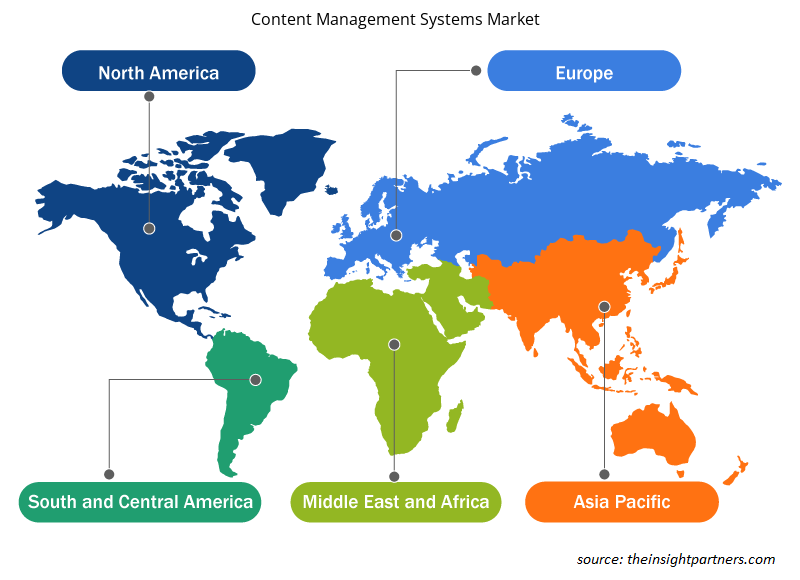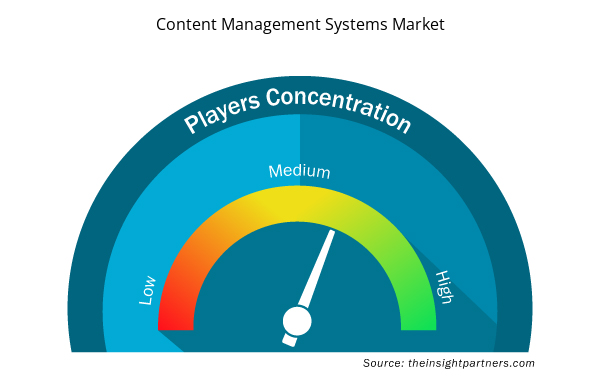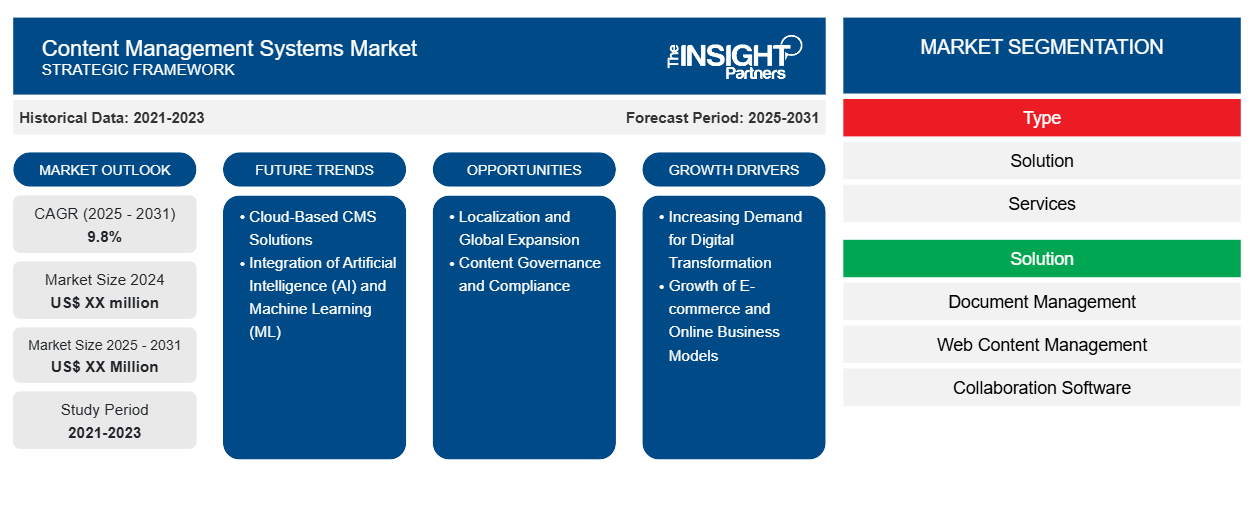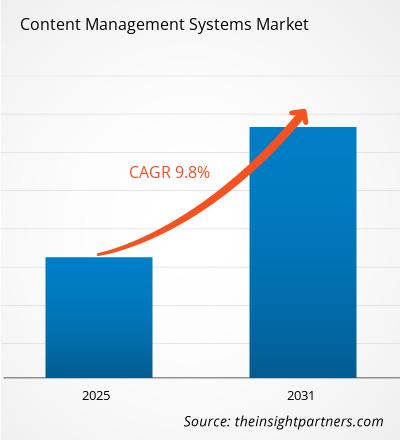من المتوقع أن يسجل سوق نظام إدارة المحتوى معدل نمو سنوي مركب بنسبة 9.8٪ من عام 2024 إلى عام 2031، مع توسع حجم السوق من XX مليون دولار أمريكي في عام 2024 إلى XX مليون دولار أمريكي بحلول عام 2031.معدل النمو السنوي المركب بنسبة 9.8% من عام 2024 إلى عام 2031، مع توسع حجم السوق من XX مليون دولار أمريكي في عام 2024 إلى XX مليون دولار أمريكي بحلول عام 2031.
تم تقسيم التقرير حسب النوع (الحل، الخدمات)، الحل (إدارة المستندات، إدارة محتوى الويب، برامج التعاون، إدارة الحقوق الرقمية، تحليلات المحتوى، أخرى)، النشر (السحابة، في الموقع)، الاستخدام النهائي (الخدمات المصرفية والمالية والتأمين، الحكومة والقطاع العام، الرعاية الصحية، تكنولوجيا المعلومات والاتصالات، التجزئة والتجارة الإلكترونية، أخرى). تم تقسيم التحليل العالمي بشكل أكبر على المستوى الإقليمي والدول الرئيسية. يقدم التقرير القيمة بالدولار الأمريكي للتحليل والقطاعات المذكورة أعلاهالخدمات المالية والمصرفية والتأمين ، والحكومة والقطاع العام، والرعاية الصحية، وتكنولوجيا المعلومات والاتصالات، وتجارة التجزئة والتجارة الإلكترونية، وغيرها). يتم تقسيم التحليل العالمي بشكل أكبر على المستوى الإقليمي والدول الرئيسية. يقدم التقرير القيمة بالدولار الأمريكي للتحليل والقطاعات المذكورة أعلاه
غرض التقرير
يهدف تقرير سوق نظام إدارة المحتوى الصادر عن The Insight Partners إلى وصف المشهد الحالي والنمو المستقبلي وأهم العوامل الدافعة والتحديات والفرص. سيوفر هذا رؤى لمختلف أصحاب المصلحة في الأعمال التجارية، مثل:
- مزودي/مصنعي التكنولوجيا: لفهم ديناميكيات السوق المتطورة ومعرفة فرص النمو المحتملة، وتمكينهم من اتخاذ قرارات استراتيجية مستنيرة.
- المستثمرون: إجراء تحليل شامل للاتجاهات فيما يتعلق بمعدل نمو السوق، وتوقعات السوق المالية، والفرص المتاحة عبر سلسلة القيمة.
- الهيئات التنظيمية: لتنظيم السياسات ومراقبة الأنشطة في السوق بهدف تقليل الانتهاكات والحفاظ على ثقة المستثمرين ودعم سلامة السوق واستقرارها.
تجزئة سوق أنظمة إدارة المحتوى
يكتب
- حل
- خدمات
حل
- إدارة المستندات
- إدارة محتوى الويب
- برامج التعاون
- إدارة الحقوق الرقمية
- تحليلات المحتوى
- آحرون
النشر
- سحاب
- في الموقع
الاستخدام النهائي
- الخدمات المالية والمصرفية والتأمين
- الحكومة والقطاع العام
- الرعاية الصحية
- تكنولوجيا المعلومات والاتصالات
- التجزئة والتجارة الإلكترونية
- آحرون
قم بتخصيص هذا التقرير ليناسب متطلباتك
ستحصل على تخصيص لأي تقرير - مجانًا - بما في ذلك أجزاء من هذا التقرير، أو تحليل على مستوى الدولة، وحزمة بيانات Excel، بالإضافة إلى الاستفادة من العروض والخصومات الرائعة للشركات الناشئة والجامعات
- احصل على أهم اتجاهات السوق الرئيسية لهذا التقرير.ستتضمن هذه العينة المجانية تحليلاً للبيانات، بدءًا من اتجاهات السوق وحتى التقديرات والتوقعات.
عوامل نمو سوق أنظمة إدارة المحتوى
- الطلب المتزايد على التحول الرقمي: مع خضوع المؤسسات في مختلف الصناعات للتحول الرقمي، تزايدت الحاجة إلى حلول إدارة المحتوى الفعّالة. تتيح منصات إدارة المحتوى للشركات إدارة المحتوى وإنشائه وتوزيعه بسلاسة عبر قنوات رقمية مختلفة. يعد الاتجاه المتزايد لنقل العمليات عبر الإنترنت وتعزيز التجارب الرقمية محركًا رئيسيًا لسوق إدارة المحتوى.
- نمو التجارة الإلكترونية ونماذج الأعمال عبر الإنترنت: مع التوسع السريع للتجارة الإلكترونية، تستثمر الشركات بشكل كبير في منصات إدارة المحتوى لتبسيط إدارة محتوى المنتج وتحسين تجربة العملاء وتحسين استراتيجيات التسويق الرقمي. تتيح حلول أنظمة إدارة المحتوى إدارة أفضل للمخزون وتسليم المحتوى المخصص والتكامل الفعال مع منصات التجارة الإلكترونية الأخرى، مما يؤدي إلى نمو السوق.
الاتجاهات المستقبلية لسوق أنظمة إدارة المحتوى
- حلول CMS المستندة إلى السحابة: تواصل الحوسبة السحابية إحداث ثورة في مشهد CMS. توفر منصات CMS المستندة إلى السحابة إمكانية التوسع والمرونة والفعالية من حيث التكلفة مقارنة بالحلول التقليدية المحلية. يتزايد استخدام CMS السحابي بسبب قدرته على دعم توزيع المحتوى العالمي والتعاون السلس وتقليل تكاليف صيانة البنية التحتية.
- دمج الذكاء الاصطناعي والتعلم الآلي: يتم دمج الذكاء الاصطناعي والتعلم الآلي بشكل متزايد في منصات إدارة المحتوى لتحسين إدارة المحتوى. يساعد الذكاء الاصطناعي في أتمتة وضع العلامات على المحتوى وتحسين قدرات البحث وتقديم توصيات محتوى مخصصة وتحليل سلوك المستخدم من أجل استراتيجيات محتوى أفضل. مع تقدم تكنولوجيا الذكاء الاصطناعي، أصبحت حلول إدارة المحتوى أكثر ذكاءً وبديهية.
فرص سوق أنظمة إدارة المحتوى
- التوطين والتوسع العالمي: مع تطلع الشركات إلى توسيع نطاق وصولها عالميًا، يصبح توطين المحتوى عاملاً بالغ الأهمية. يمكن أن توفر حلول CMS الترجمة الآلية وأدوات التوطين والدعم متعدد اللغات، مما يتيح للشركات تخصيص محتواها لمناطق ولغات مختلفة، وبالتالي توسيع نطاق وصولها إلى السوق وتحسين مشاركة العملاء على نطاق عالمي.
- حوكمة المحتوى والامتثال له: مع وجود لوائح أكثر صرامة لحماية البيانات مثل GDPR وCCPA، تبحث الشركات بشكل متزايد عن حلول CMS التي يمكنها ضمان امتثال المحتوى والحوكمة. يمكن أن تساعد منصات CMS في أتمتة سير عمل الامتثال، وتوفير مسارات التدقيق، وإنفاذ سياسات المحتوى، مما يوفر فرصة كبيرة للبائعين الذين يقدمون ميزات حوكمة محتوى قوية.
رؤى إقليمية حول سوق أنظمة إدارة المحتوى
لقد قام المحللون في Insight Partners بشرح الاتجاهات والعوامل الإقليمية المؤثرة على سوق أنظمة إدارة المحتوى طوال فترة التوقعات بشكل شامل. يناقش هذا القسم أيضًا قطاعات سوق أنظمة إدارة المحتوى والجغرافيا في جميع أنحاء أمريكا الشمالية وأوروبا ومنطقة آسيا والمحيط الهادئ والشرق الأوسط وأفريقيا وأمريكا الجنوبية والوسطى.

- احصل على البيانات الإقليمية المحددة لسوق أنظمة إدارة المحتوى
نطاق تقرير سوق أنظمة إدارة المحتوى
| سمة التقرير | تفاصيل |
|---|---|
| حجم السوق في عام 2024 | XX مليون دولار أمريكي |
| حجم السوق بحلول عام 2031 | XX مليون دولار أمريكي |
| معدل النمو السنوي المركب العالمي (2024 - 2031) | 9.8% |
| البيانات التاريخية | 2021-2023 |
| فترة التنبؤ | 2025-2031 |
| القطاعات المغطاة | حسب النوع
|
| المناطق والدول المغطاة | أمريكا الشمالية
|
| قادة السوق وملفات تعريف الشركات الرئيسية |
|
كثافة اللاعبين في سوق أنظمة إدارة المحتوى: فهم تأثيرها على ديناميكيات الأعمال
يشهد سوق أنظمة إدارة المحتوى نموًا سريعًا، مدفوعًا بالطلب المتزايد من المستخدم النهائي بسبب عوامل مثل تفضيلات المستهلكين المتطورة والتقدم التكنولوجي والوعي المتزايد بفوائد المنتج. ومع ارتفاع الطلب، تعمل الشركات على توسيع عروضها والابتكار لتلبية احتياجات المستهلكين والاستفادة من الاتجاهات الناشئة، مما يؤدي إلى زيادة نمو السوق.
تشير كثافة اللاعبين في السوق إلى توزيع الشركات أو المؤسسات العاملة في سوق أو صناعة معينة. وهي تشير إلى عدد المنافسين (اللاعبين في السوق) الموجودين في مساحة سوق معينة نسبة إلى حجمها أو قيمتها السوقية الإجمالية.
الشركات الرئيسية العاملة في سوق أنظمة إدارة المحتوى هي:
- شركة أوراكل
- شركة أوبن تكست
- شركة سيسكو سيستمز
- شركة آي بي إم
- شركة إي إم سي
إخلاء المسؤولية : الشركات المذكورة أعلاه ليست مرتبة بأي ترتيب معين.

- احصل على نظرة عامة على أهم اللاعبين الرئيسيين في سوق أنظمة إدارة المحتوى
نقاط البيع الرئيسية
- التغطية الشاملة: يغطي التقرير بشكل شامل تحليل المنتجات والخدمات والأنواع والمستخدمين النهائيين لسوق نظام إدارة المحتوى، مما يوفر صورة شاملة.
- تحليل الخبراء: تم تجميع التقرير على أساس الفهم العميق لخبراء الصناعة والمحللين.
- معلومات محدثة: يضمن التقرير أهمية الأعمال التجارية بسبب تغطيته للمعلومات الحديثة واتجاهات البيانات.
- خيارات التخصيص: يمكن تخصيص هذا التقرير لتلبية متطلبات العملاء المحددة وبما يتناسب مع استراتيجيات العمل بشكل مناسب.
وبالتالي، يمكن أن يساعد تقرير البحث حول سوق نظام إدارة المحتوى في تمهيد الطريق لفك شفرة وفهم سيناريو الصناعة وآفاق النمو. ورغم وجود بعض المخاوف المشروعة، فإن الفوائد الإجمالية لهذا التقرير تميل إلى التفوق على العيوب.
- التحليل التاريخي (سنتان)، السنة الأساسية، التوقعات (7 سنوات) مع معدل النمو السنوي المركب
- تحليل PEST و SWOT
- حجم السوق والقيمة / الحجم - عالميًا وإقليميًا وقطريًا
- الصناعة والمنافسة
- مجموعة بيانات Excel



Report Coverage
Revenue forecast, Company Analysis, Industry landscape, Growth factors, and Trends

Segment Covered
This text is related
to segments covered.

Regional Scope
North America, Europe, Asia Pacific, Middle East & Africa, South & Central America

Country Scope
This text is related
to country scope.
الأسئلة الشائعة
The report can be delivered in PDF/PPT format; we can also share excel dataset based on the request
Headless CMS architecture to play a significant role in the global content management system market in the coming years
The Content Management System Market is estimated to witness a CAGR of 9.8% from 2023 to 2031
Digital transformation initiatives and rising demand for personalized content are the major factors driving the content management system market
Trends and growth analysis reports related to Technology, Media and Telecommunications : READ MORE..
1. Oracle Corporation
2. OpenText Corporation
3. Cisco Systems Inc
4. IBM Corporation
5. EMC Corporation
6. Microsoft Corporation
7. Hyland Software
8. Xerox Corporation
9. T- Systems Ltd
10. Integro Inc
11. Deloitte
The Insight Partners performs research in 4 major stages: Data Collection & Secondary Research, Primary Research, Data Analysis and Data Triangulation & Final Review.
- Data Collection and Secondary Research:
As a market research and consulting firm operating from a decade, we have published and advised several client across the globe. First step for any study will start with an assessment of currently available data and insights from existing reports. Further, historical and current market information is collected from Investor Presentations, Annual Reports, SEC Filings, etc., and other information related to company’s performance and market positioning are gathered from Paid Databases (Factiva, Hoovers, and Reuters) and various other publications available in public domain.
Several associations trade associates, technical forums, institutes, societies and organization are accessed to gain technical as well as market related insights through their publications such as research papers, blogs and press releases related to the studies are referred to get cues about the market. Further, white papers, journals, magazines, and other news articles published in last 3 years are scrutinized and analyzed to understand the current market trends.
- Primary Research:
The primarily interview analysis comprise of data obtained from industry participants interview and answers to survey questions gathered by in-house primary team.
For primary research, interviews are conducted with industry experts/CEOs/Marketing Managers/VPs/Subject Matter Experts from both demand and supply side to get a 360-degree view of the market. The primary team conducts several interviews based on the complexity of the markets to understand the various market trends and dynamics which makes research more credible and precise.
A typical research interview fulfils the following functions:
- Provides first-hand information on the market size, market trends, growth trends, competitive landscape, and outlook
- Validates and strengthens in-house secondary research findings
- Develops the analysis team’s expertise and market understanding
Primary research involves email interactions and telephone interviews for each market, category, segment, and sub-segment across geographies. The participants who typically take part in such a process include, but are not limited to:
- Industry participants: VPs, business development managers, market intelligence managers and national sales managers
- Outside experts: Valuation experts, research analysts and key opinion leaders specializing in the electronics and semiconductor industry.
Below is the breakup of our primary respondents by company, designation, and region:

Once we receive the confirmation from primary research sources or primary respondents, we finalize the base year market estimation and forecast the data as per the macroeconomic and microeconomic factors assessed during data collection.
- Data Analysis:
Once data is validated through both secondary as well as primary respondents, we finalize the market estimations by hypothesis formulation and factor analysis at regional and country level.
- Macro-Economic Factor Analysis:
We analyse macroeconomic indicators such the gross domestic product (GDP), increase in the demand for goods and services across industries, technological advancement, regional economic growth, governmental policies, the influence of COVID-19, PEST analysis, and other aspects. This analysis aids in setting benchmarks for various nations/regions and approximating market splits. Additionally, the general trend of the aforementioned components aid in determining the market's development possibilities.
- Country Level Data:
Various factors that are especially aligned to the country are taken into account to determine the market size for a certain area and country, including the presence of vendors, such as headquarters and offices, the country's GDP, demand patterns, and industry growth. To comprehend the market dynamics for the nation, a number of growth variables, inhibitors, application areas, and current market trends are researched. The aforementioned elements aid in determining the country's overall market's growth potential.
- Company Profile:
The “Table of Contents” is formulated by listing and analyzing more than 25 - 30 companies operating in the market ecosystem across geographies. However, we profile only 10 companies as a standard practice in our syndicate reports. These 10 companies comprise leading, emerging, and regional players. Nonetheless, our analysis is not restricted to the 10 listed companies, we also analyze other companies present in the market to develop a holistic view and understand the prevailing trends. The “Company Profiles” section in the report covers key facts, business description, products & services, financial information, SWOT analysis, and key developments. The financial information presented is extracted from the annual reports and official documents of the publicly listed companies. Upon collecting the information for the sections of respective companies, we verify them via various primary sources and then compile the data in respective company profiles. The company level information helps us in deriving the base number as well as in forecasting the market size.
- Developing Base Number:
Aggregation of sales statistics (2020-2022) and macro-economic factor, and other secondary and primary research insights are utilized to arrive at base number and related market shares for 2022. The data gaps are identified in this step and relevant market data is analyzed, collected from paid primary interviews or databases. On finalizing the base year market size, forecasts are developed on the basis of macro-economic, industry and market growth factors and company level analysis.
- Data Triangulation and Final Review:
The market findings and base year market size calculations are validated from supply as well as demand side. Demand side validations are based on macro-economic factor analysis and benchmarks for respective regions and countries. In case of supply side validations, revenues of major companies are estimated (in case not available) based on industry benchmark, approximate number of employees, product portfolio, and primary interviews revenues are gathered. Further revenue from target product/service segment is assessed to avoid overshooting of market statistics. In case of heavy deviations between supply and demand side values, all thes steps are repeated to achieve synchronization.
We follow an iterative model, wherein we share our research findings with Subject Matter Experts (SME’s) and Key Opinion Leaders (KOLs) until consensus view of the market is not formulated – this model negates any drastic deviation in the opinions of experts. Only validated and universally acceptable research findings are quoted in our reports.
We have important check points that we use to validate our research findings – which we call – data triangulation, where we validate the information, we generate from secondary sources with primary interviews and then we re-validate with our internal data bases and Subject matter experts. This comprehensive model enables us to deliver high quality, reliable data in shortest possible time.


 احصل على عينة مجانية لهذا التقرير
احصل على عينة مجانية لهذا التقرير